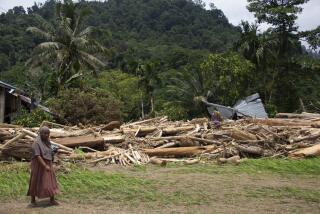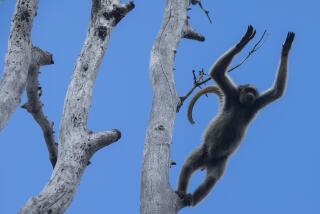O.C. Conference to Chart Orangutan’s Survival Plan
- Share via
FULLERTON — Sacrificed to a worldwide demand for mahogany to fashion into desks and dining tables, lost to a need for land to feed a growing population, the rain forests of Borneo and Sumatra are fast dwindling. And as these big trees fall, so too goes the only habitat of the orangutan.
Today, half a world away from where the species is making its last stand, scientists, zoo administrators, conservationists and government officials meet at Cal State Fullerton to assess the accelerating threats facing the orangutan and forge a strategy to help it survive.
“The ultimate problem, like it is for so many species on this planet, is habitat destruction,” said Birute Galdikas, co-founder of the Los Angeles-based Orangutan Foundation International, who has spent the last 23 years studying orangutans in the forests of Borneo. “Without the trees they simply cannot survive.”
Uncertainties abound over just how many orangutans remain in the wild, but experts believe as much as half the population has been lost over the past decade, and the shaggy red ape could be extinct soon after the turn of the century if current deforestation practices continue.
Named for an Indonesian phrase meaning “man of the forest,” orangutans are the most solitary of the great apes, ranging widely as they travel through the forest canopy. As development of their once-lush island habitat continues, the highly intelligent animals--among the closest living relatives to humankind--are forced to survive in smaller and more isolated pockets of protected land.
Two large islands in the Indonesian archipelago, Borneo and Sumatra, were still heavily covered with forests when Galdikas began her independent studies in 1971. Since then, an estimated 80% of the orangutan’s habitat has been cleared, both through commercial logging and agriculture. The orangutan population is estimated today at anywhere from 20,000 to 50,000.
Organizers hope this weekend’s conference will go beyond traditional academic presentations to plans for protecting the endangered primate.
“Usually, at these kinds of sessions you go, you read your paper and you go home,” said Lori Sheeran, faculty adviser for the conference. “Here, we want something concrete.”
In the past, academic conferences have had “a minimal impact on conservation of species,” said Ulysses Seal, a conservation biologist. “This reflects a longstanding division between the academic and the conservation communities.” That division, he said, is slowly dissolving, as the Fullerton conference illustrates.
Titled “Orang utans: The Neglected Ape,” the three-day meeting was organized by Norm Rosen, a graduate student in anthropology at Cal State Fullerton who learned in the course of his research two years ago that there hadn’t been a major academic conference on the animal since 1979.
“It’s been so many years since conservationists and field people and zoo people have gotten together to discuss the problems facing orangutans,” Rosen said. He approached the faculty of the university’s anthropology department and decided to organize the conference as his master’s project.
A number of individuals and organizations have worked together to bring the conference to Fullerton, including the school’s Anthropology Student Assn., the Zoological Society of San Diego and Zoo Atlanta.
Even with a renewed commitment from the Indonesian government, deforestation and illegal hunting--for food and for the pet trade--continue. Much of the logging is selective, but often the trees left standing by loggers are quickly felled to make room for agriculture.
Also, said Mark Leighton a Harvard University professor, too little is known about the eating habits and movements of the animal to create an effective management plan.
“There’s a strong need for better surveys of remaining forested areas in Borneo, and in some cases a redesign of the reserve system,” Leighton said. Also, he said, “it has to be approached as a comprehensive problem, not just orangutans.”
Borneo and Sumatra are home to a number of equally endangered forest species, many of them found nowhere else: proboscis monkeys, clouded leopards, Sumatran tigers, even rhinoceroses.
The conservation situation in Sumatra is somewhat different. The island, all of which is part of the nation of Indonesia, has a single national park of more than 2.2 million acres. Partly as a result of a workshop organized by Seal in Sumatra last year, the Indonesian government has set as a goal a sustained population of 10,000 orangutans on that island. Seal estimates there are currently about 8,500 on the island, some 30% of them living outside the national park on less-protected lands.
The success of the Indonesian effort will depend largely on international financial support for park management and basic research, Seal said.
Almost 60 professionals will make presentations at the conference, and about 200 more will attend. In addition to Galdikas and Seal, other top orangutan experts to take part include J.A.R.A.M. van Hooff of Rijksuniversiteit Utrecht in the Netherlands, Jito Sugardjito, an Indonesian scientist affiliated with the World Wildlife Fund, and Terry L. Maple, director of Zoo Atlanta.
Through accounts in the mainstream press and on television, Galdikas is probably the best known to the public. She is one of the so-called “Leakey’s Angels,” three students of famed anthropologist Louis Leakey, who went out to study great apes in their natural homes. Jane Goodall, famous for her studies of chimpanzees, was another; Dian Fossey, who championed the preservation of the mountain gorilla until her murder in 1985, was the third.
In recent years, Galdikas has spent increasing amounts of her energy on promoting preservation, leading some to criticize her for neglecting research.
She downplays such comments: “I think, given the desperate nature of the situation, we must consider the conservation issues to be of primary importance,” Galdikas said by telephone from a home she maintains in Los Angeles.
Her relationship with the Indonesian government has been strained at times, but Galdikas said she has seen a major shift in the last year. “I think there’s a new maturity in the Indonesian forestry department,” she said. “I’ve been very, very pleased.”
The 1990s are “a critical decade” in determining whether the orangutan will survive in the wild, said Leighton, the Harvard University researcher who has done field work in Borneo for 20 years. There is hope, he said, but that hope hinges on a number of needs: more research on how the animals live, better management schemes, more money and training to implement those plans.
Still, obstacles remain in Kalimantan, the Indonesian state that comprises the southern two-thirds of Borneo (most of the northern part of the island is under Malaysian control). Orangutans there number between 10,000 and 15,000, by Leighton’s best guess, but many of those are in scattered and fragmented populations that may be too small to survive over time.
The theme of this weekend’s conference, “The Neglected Ape,” reflects the belief of many that orangutans get less press than their more-publicized cousins, the gorillas and the chimpanzees, and that an increased public awareness could lead to more dollars for conservation.
As far as Galdikas is concerned, however, the orangutan has suffered from too much attention--of the wrong kind, from loggers and poachers. “I think what the orangutans need is a lot more neglect,” she said.
Galdikas said she still feels the same connection with her research subjects as when she first went into the jungle as a UCLA graduate of 25, a connection amplified by a sense of urgency over their fate.
“When you look into an orangutan’s eyes, the eyes that look back mirror our own,” she said. “We recognize his or her affinity, that there is something else on this earth that is almost us. In a way, we’re looking at where we’ve been.”
More to Read
Sign up for Essential California
The most important California stories and recommendations in your inbox every morning.
You may occasionally receive promotional content from the Los Angeles Times.













